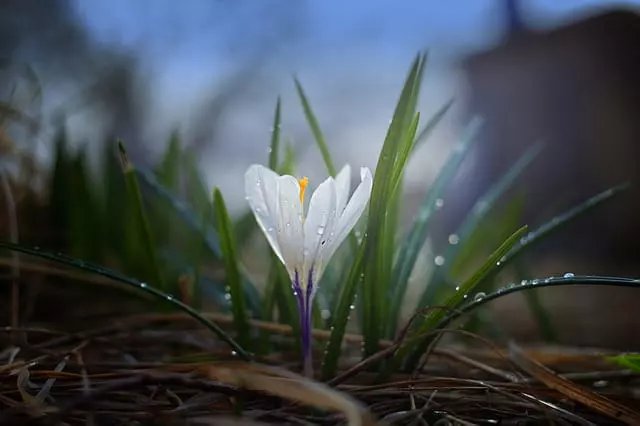Crocus is fall bulbs that are usually planted massively. The reason is very simple, planted in groups they offer a spectacle of flowering, but in solitary, they pass very unnoticed because they are very small plants, and with flowers according to their size. Learn all about how to grow Crocus in this article.
Along with tulips, hyacinths, and daffodils, they are the most used bulbous plants in gardening, and unlike them, they have no value as cut flowers.
There are about 100 different species of crocus, but only about 30 are commonly planted. Among these species, the best known is undoubtedly the Crocus sativus, from which saffron is obtained.
In addition to planting them in large groups, under trees or among the lawn, they are also very good as a border or among the rockery.
They are among the first spring flowers to appear, so planting a few crocus is essential to know that there is very little time left for the actual change of season.
Table of Contents
Description
Crocus is an herbaceous perennial plant, which appears from bulbs. Their flowering is very early, they are the first bulbs to do so, even before spring arrives. They only need the soil to begin to warm up.
Their average height ranges between 2.75″ and 6″ (7 and 15 cm), never exceeding 8″ (20 cm), although their leaves can be much longer.
It is easy to distinguish crocus from other similar plants, since their leaves have in all their varieties, a white central striation.
Crocus Flowers
The flowers of the crocus are formed by 6 sepals, distributed in two series of three, being the external sepals a little bigger than the internal ones.
As a curiosity, the tepals are united at the bottom, forming a very long tube that emerges almost at ground level.
Some varieties, very few, have flowers with a delicious honey perfume.
As for the colors of its flowers is quite diverse, you have three basic colors of crocus: white, yellow, and purple, but from there the differences in shades are enormous.
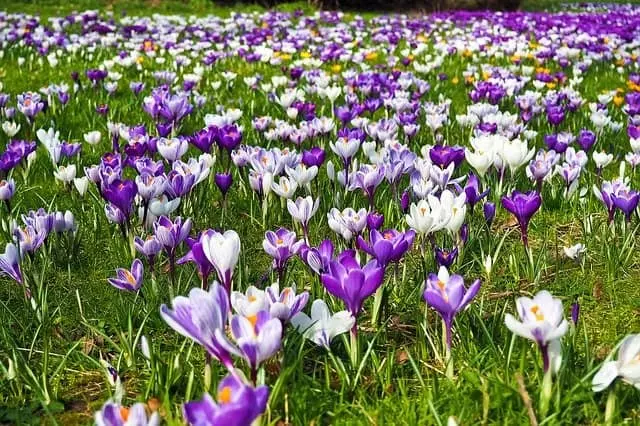
Crocus Varieties
There are many varieties of Crocus to grow., but some of them are the most popular are:
Crocus sativus
Commonly called saffron or saffron flower, although this spice comes from the dried stigmas of the pistil of the Crocus sativus flower.
From each bulb of Crocus sativus usually appear two or three purplish flowers, measuring about 1.6″ (4 cm) in length.
It is perfectly adapted to our Mediterranean climate, with very dry summers and very cold winters. Its care does not differ in any way from what would be a garden crocus.
Crocus nudiflorus, crazy saffron, or false saffron
Originally from southern Europe, it is a crocus that can reach 8″ (20 cm) in height.
It is usually found wild in pastures and high mountain meadows, where it can bloom between late autumn and early spring.
It is very hardy, hardy and is easy to find in a variety of colors, the most common being lilac.
Crocus vernus, Dutch Crocus
It is a crocus native to the highlands of southern Europe. From different crosses and hybridizations, it is the ancestor of many of the garden varieties, with large flowers and known as Dutch crocus.
There are many popular varieties of Crocus vernus: Black Boy, Pickwick, Porpureus Grandiflorus…
Crocus chrysanthus
A variety native to the Balkans and Turkey, it offers bowl-shaped flowers, usually in orange-yellow colors.
Its flower is smaller than that of Crocus vernus, although as a counterpart it offers a greater number of flowers per bulb. It is an early flowering plant.
Crocus caeruleus
It is native to Bosnia and Herzegovina. The most outstanding feature of this crocus is that they have bright yellow perfumed flowers, with brown spots on their outer petals.
How to Grow Crocus
Crocus bloom in late winter or early spring…precisely because they tend to bloom when the weather is not yet good, they are perfect for adding color to a garden without flowers.
Because their flowers and size are relatively small, the best results are obtained by planting large numbers of crocus at once, so that they generate a large bloom.
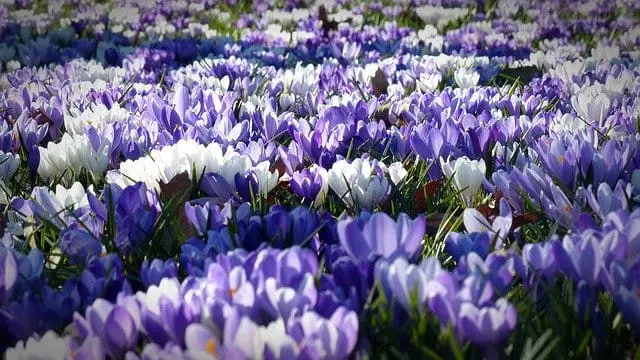
How to Grow Crocus Step by Step
Planting crocus is not complicated and does not differ too much from planting any other type of bulb, although it is always good to remember the key points, distances…
To be successful with the cultivation of crocus keep in mind:
- They are small bulbs, planting them about 2″ (5 cm) deep is enough.
- Between bulb and bulb, the distance can vary between 2″ and 3″ (5 and 8 cm), depending on the size of the bulbs.
- If we are going to plant a good number of crocus in the lawn (100 to 150 bulbs), it is recommended to throw them away and plant them where they have fallen, to generate a greater sense of naturalness.
- Be careful that the bulb bud points upwards.
- Once planted, and if the soil is not wet, water abundantly.
If you want to grow quality Crocus we recommend these (Order it here) or these (Order it here).
- Best value crocus blend/Best planted in groups or drifts/Glorious, early spring color
- These are the well-known spring blooming Crocus, that are long-lived and everyone knows and loves
- Bulb Size: 8/9 cm/Exposure: Full sun to partial shade/Blooms: Early Spring/Plant Time: Fall
How to Care Crocus
Crocus is a relatively simple bulbous plant to care for, you just need to take care of a few details to have a beautiful bloom.
To grow Crocus correctly, follow the tips below.
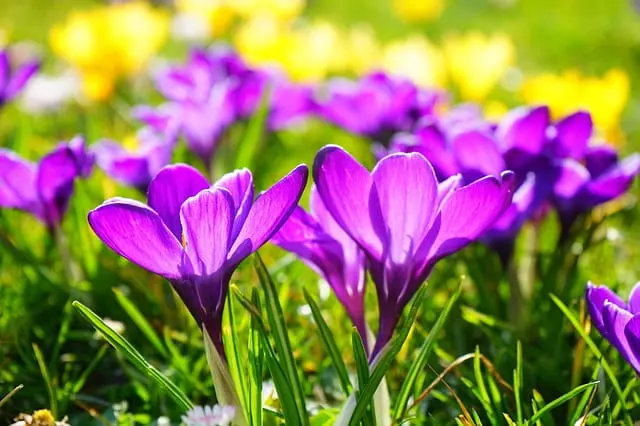
How to Grow Crocus – Soil
They prefer loose, well-draining soils with a good amount of organic matter…although they can survive in poor soils, if we want them to grow and flower well, the soil should have enough nutrients.
We can work the place where they will be planted, adding good compost and sand, to prevent waterlogging and also have the nutrients that crocus need.
They are very resistant to cold, so they are ideal for planting in pots. The advice is the same, a pot with compost that drains well and has a good amount of nutrients.
- Grows Plants Twice as Big (vs. unfed plants)
- Feeds up to 6 months
- More blooms for more color (vs. unfed plants)
How to Grow Crocus – Sun Exposure
Crocus will be perfect in full sun, but if the area of the garden chosen has semi-sun, that’s fine, they adapt perfectly.
They are very hardy and resistant to cold, withstanding temperatures as low as -4 °F (-20ºC).
How to Grow Crocus – Watering
More than watering, what we need is that the soil is kept slightly humid.
If due to the climatic situation, the soil does not dry out, watering is not necessary.
It is convenient that the soil does not become waterlogged, because it could cause rotting of the bulbs by fungal attacks, that if we must monitor it well.
How to Grow Crocus – Fertilizing
If we have done well on the task of soil preparation, it is not necessary to provide extra fertilizer.
To grow Crocus we recommend this fertilizer that we use on our bulbs (Order it here).
- FOR USE ON: Use Bulb-tone organic fertilizer for all Fall bulbs like tulips, daffodils, crocus & hyacinths and on Spring bulbs like gladioli and lilies
- CONTAINS: Bulb-tone is a rich blend of the finest natural & organic ingredients enhanced with our exclusive Bio-tone formula; 3-5-3 Fertilizer analysis with 6% Calcium. Bulb-tone is environmentally Safe - No sludges or toxic ingredients
- WHEN / HOW TO USE: Best to use Bulb-tone fertilizer when planting or feeding post bloom on spring flowering bulbs; place directly in the planting hole for new bulbs and sprinkle on the soil surface for established plants then water thoroughly. Bulb-tone is ready to use and requires no mixing
How to Grow Crocus – Pests
They do not usually present pest problems, except for the attack of some fungi if the soil situation is not correct.
How to Propagate Crocus
Like most bulbs and bulbs, they produce bulbs spontaneously.
Once the plant has finished flowering and its aerial part has dried, we can proceed to dig up the bulbs of the crocus.
This must be done carefully, to avoid damaging the bulbs and any bulblets that may have been generated.
We separate the crocus bulbs from the larger bulbs, to plant them the following year independently until they are big enough to flower.
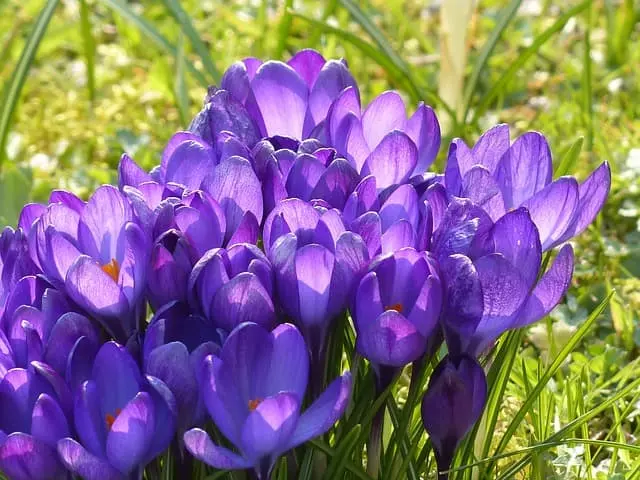
How to Store Crocus Bulbs
This task is crucial to have crocus flowers year after year. Follow the tips below to keep crocus in your garden for years to come:
- The bulbs can be dug up when the leaves begin to yellow or when they dry out completely.
- If we take them out before they completely wither, they should be left in a dry, shady, and well-ventilated place to finish drying.
- They can be left on trays or in mesh bags.
- Once dry, remove the stems and clean them well, eliminating any damaged or defective ones.
- The mesh bags are perfect for storing them. We have to be careful to label them by color, variety…
- Afterward, we will keep them in a dark, well-ventilated place with a temperature between 73 °F and 80 °F (23ºC and 27ºC).
We hope this article on how to grow Crocus will be useful. We recommend our article about How to Grow Fresia.
